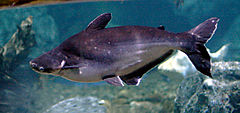Pangasianodon
| Pangasianodon[1] | |
| Chevey, 1931 | |
 Przedstawiciel rodzaju – Pangasianodon hypophthalmus | |
| Systematyka | |
| Domena | eukarionty |
| Królestwo | zwierzęta |
| Typ | strunowce |
| Podtyp | kręgowce |
| Nadgromada | kostnoszkieletowe |
| Gromada | promieniopłetwe |
| Podgromada | nowopłetwe |
| Infragromada | doskonałokostne |
| Nadrząd | otwartopęcherzowe |
| Rząd | sumokształtne |
| Rodzina | Pangasiidae |
| Rodzaj | Pangasianodon |
Pangasianodon – rodzaj słodkowodnych ryb sumokształtnych z rodziny Pangasiidae.
Zasięg występowania
Klasyfikacja
Gatunki zaliczane do tego rodzaju[2]:
- Pangasianodon gigas – pangaz[3] („pangazjanodon”[a])
- Pangasianodon hypophthalmus – sum rekini[4]
Sum rekini albinos - forma hodowlana suma rekiniego
Sum rekini - rozwój
Sum rekini głowa
Uwagi
- ↑ Zaproponowana w 1973 nazwa „pangazjanodon” (Mały słownik zoologiczny, Ryby, Wiedza Powszechna, Warszawa 1973) została skrytykowana przez Eugeniusza Grabdę (Przegląd zoologiczny, XVIII, 1, 1974, s. 126-128) i w wydaniu z 1976 zastąpiona nazwą „pangaz”.
Przypisy
- ↑ Pangasianodon, [w:] Integrated Taxonomic Information System [online] (ang.).
- ↑ Ron Fricke, William Neil Eschmeyer, Richard Van der Laan (red.), SEARCH, [w:] Eschmeyer's Catalog of Fishes [online], California Academy of Sciences, 30 kwietnia 2013 [dostęp 2013-05-31] (ang.).
- ↑ Ryby. Warszawa: Wiedza Powszechna, 1973 (wyd. II 1976), seria: Mały słownik zoologiczny.
- ↑ Eugeniusz Grabda, Tomasz Heese: Polskie nazewnictwo popularne krągłouste i ryby - Cyclostomata et Pisces. Koszalin: Wyższa Szkoła Inżynierska w Koszalinie, 1991.
Media użyte na tej stronie
Autor: (of code) -xfi-, Licencja: CC BY-SA 3.0
The Wikispecies logo created by Zephram Stark based on a concept design by Jeremykemp.
Autor: Staticd, Licencja: CC BY-SA 3.0
Individual approx 500g, 40cm long; Anal rays 27; Pelvic rays 8; Dorsal rays 6+ spine; Pectoral rays ~8; Serrated spine ahead of both dorsal and pectoral fin; 2 pairs of barbels (1 chin and 1 maxillary); Vomeral teeth in narrow cresent shaped ridge, palatal teeth in two halves of a very narrow cresent. Swim bladder extended past anal fin. no lobes visible(?). ID based on barbel length, head profile, number of anal rays, dentition and single lobed swim bladder using (Roberts, Tyson R.; Chavalit Vidthayanon (1991-01-01). "Systematic Revision of the Asian Catfish Family Pangasiidae, with Biological Observations and Descriptions of Three New Species". Proceedings of the Academy of Natural Sciences of Philadelphia 143: 97–143. DOI:10.2307/4064995. ISSN 0097-3157. Retrieved on 2013-01-16.) see File:Pangasianodon_hypophthalmus.jpg for lateral view. Individual got at a Pune fish market.
Autor: Hectonichus, Licencja: CC BY-SA 3.0
Pangasius sanitwongsei (juvenile), at the Museo di Storia Naturale e del Territorio, Calci (Province Pisa), Italy
Autor: Emőke Dénes, Licencja: CC BY-SA 4.0
Albino iridescent shark (Pangasianodon hypophthalmus) in Southend-on-Sea aquarium, England.
Autor: Vassil, Licencja: CC0
Pangasius sutchi ( Pangasianodon hypophthalmus ) albinos, à l'Aquarium de Dunkerque.
Autor: Carkuni (talk), Licencja: CC-BY-SA-3.0
Mekong giant catfish (Photo in Gifu World Fresh Water Aquarium by Carkuni (talk))
Autor: User:Lerdsuwa, Licencja: CC-BY-SA-3.0
Incandescent shark catfish Pangasius hypophthalmus
Autor: Cymothoa exigua, Licencja: CC BY-SA 3.0
Development of Pangasianodon hypophthalmus. Freshly hatched larva, 4 days old larva and 14 days old fingerling. Black bars indicate 1 mm
Autor: User:Melanochromis, Licencja: CC-BY-SA-3.0
iridescent shark catfish Pangasius hypophthalmus

















